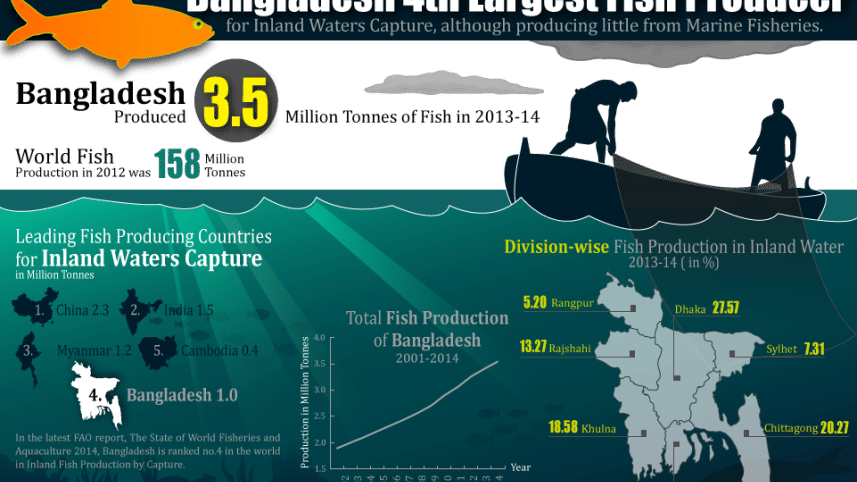Fish delight

The country's fish production has almost doubled in just over a decade as fish farming becomes even more popular.
According to data from the Department of Fisheries, farmed fish production was 2 million tonnes in 2013-14 fiscal year. This was only 0.8 million tonnes in 2001-02.
During this period, the overall fish production increased by a staggering 88 percent.
This is great news for the nation as fish accounts for about 56 percent of animal protein we consume.
According to the fisheries department, the country produced about 3.5 million tonnes of fish in 2013-14. Of this, 2.9 million tonnes came from farms and catches from various inland water sources. Only 0.6 million tonnes were from the sea.
In 2001-02, the total fish production stood at 1.9 million tonnes and most of it came from various inland water sources.
This rise in fish culture is due to high quality fish feed and fry production, and widespread induced breeding technology, the department says. Another reason that boosted fish production is the Jatka Conservation Project that imposed a ban on hilsa fishing.
One of the key sources of fresh water fish in the country is the numerous ponds in our villages, comprising of about 0.4 million hectare area that produce half the inland fresh water fish.
Approximately 4.7 million hectares across the country are used for inland fisheries. Dhaka division delivers 28 percent of the total inland fish production; followed by Chittagong, Khulna and Rajshahi ranging between 13 percent and 20 percent. Rangpur contributes the least with just 5 percent.
As per the Food and Agriculture Organisation (FAO), global fish production was 158 million tonnes in 2012 and per capita fish consumption was 19.2kg.
Annual consumption of fish and fish products in Bangladesh was 12kg/per person in 2010, with Chittagong having highest annual consumption of about 17kg/per person.
In Bangladesh, about three quarters of consumed fish are fresh water fish, among which Pangas, Rui, and Tilapia top the chart.
Pangas farming has become an established agro-processing industry in the country over the last decade. Pangas is most easy to produce due to its short culture-cycle, high growth rate and unselective feeding habit. It also has good resistance to diseases. These characteristics are somewhat present in Tilapia.
Export of fish and fish products increased by 86 percent from 2001-02 and reached 77,000 tonnes in 2013-14.
Although, the country's exports reached its peak of about 96,000 tonnes in the fiscal year 2010-11, it declined in recent years. One of the reasons behind the decline could be the ban on hilsa export, set to ensure the country was not deprived of the delicacy.
According to the latest FAO report, the state of World Fisheries and Aquaculture 2014, Bangladesh continues to be the fourth largest fish producer in the world in terms of capturing fish from inland waters.
FAO predicts that Bangladesh would be the first of four countries, Thailand, India, and China, to experience the highest growth rate in terms of fish production by 2022.



 For all latest news, follow The Daily Star's Google News channel.
For all latest news, follow The Daily Star's Google News channel.
Comments